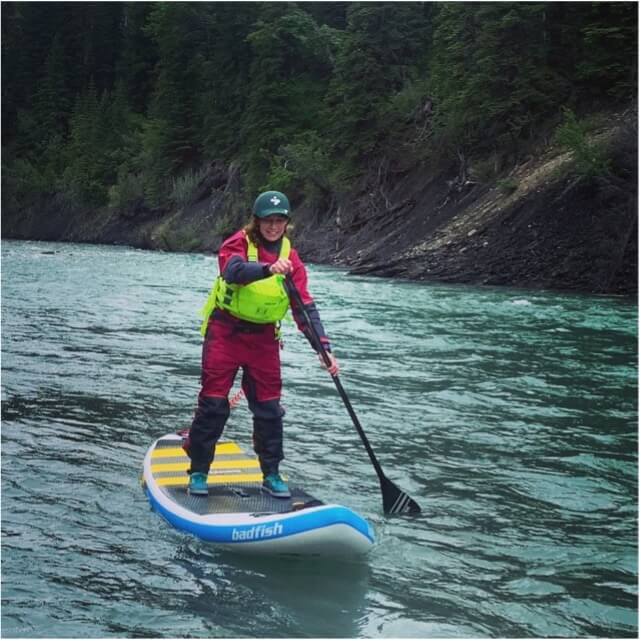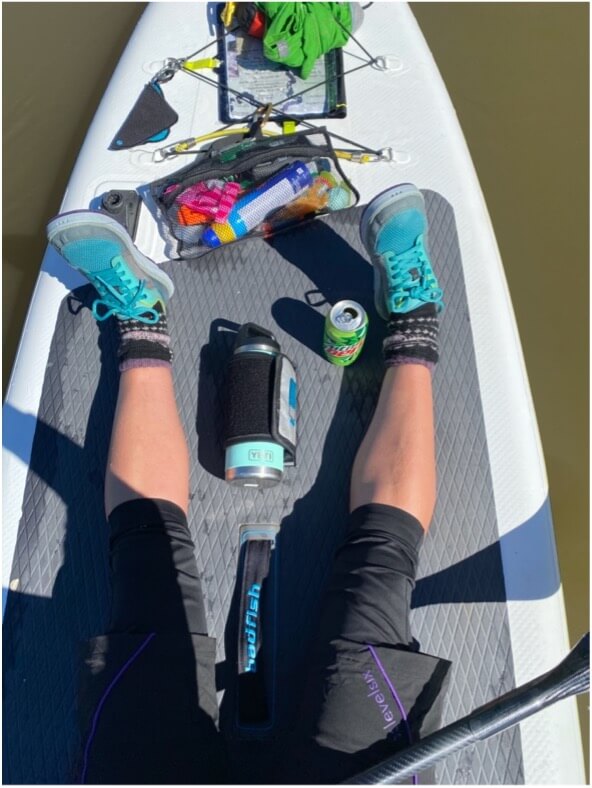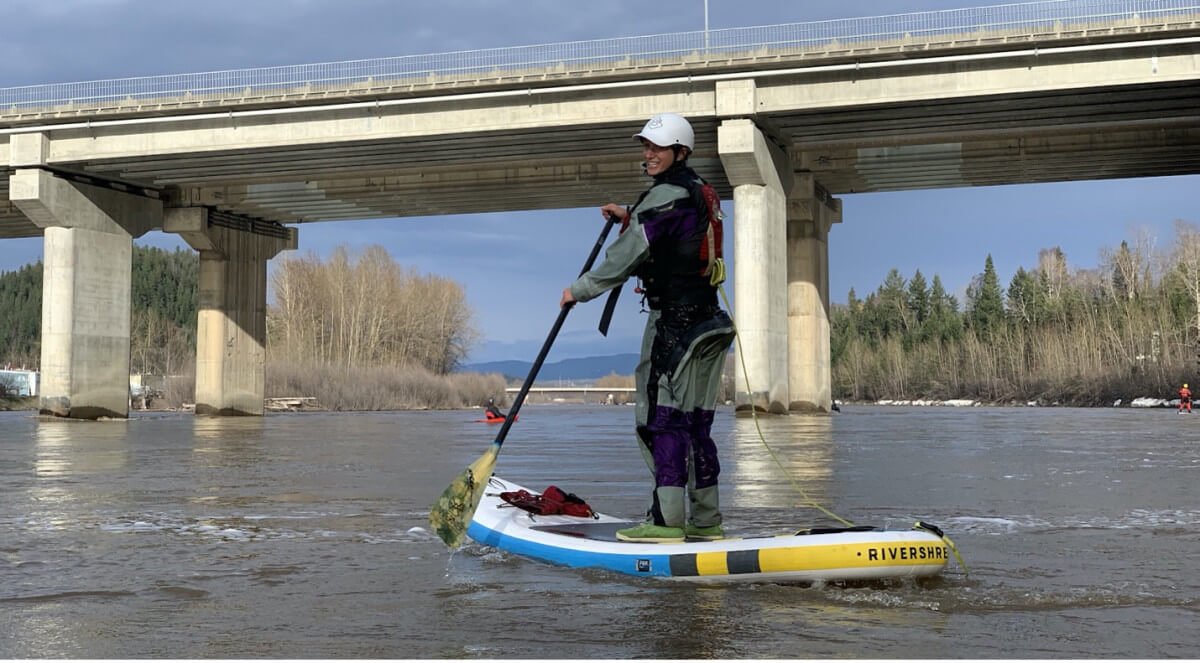Whitewater what? River SUP?
You might still be in a bit of disbelief right now.
Let’s try again.
From the simple current flows to the raging whitewater of the rivers, Stand Up Paddling on moving water is a developing and rewarding sport. I want to be clear with you from the start: you do not have to send yourself down the river alongside the adrenaline seeking whitewater enthusiasts. You can also paddle slow moving rivers and still have fun.
But for those adrenaline seekers, see “Figure A” below!
Figure A, Credit to @mci_graham
Yes that’s me in the white helmet, staying up right on my feet. I have been whitewater stand up paddling for 8 years now. This is not my everyday paddling.
I started off as a landlocked surfer in BC’s interior trying to find my way back to the water. Someone told me you can surf on the river; my reply of course was “What do I gotta do?”
I found myself falling passionately into river stand up paddling, especially river running, and exploring the unlimited rivers Western Canada has to offer. It’s led me to follow through the Paddle Canada SUP instructor stream and graciously accept the offer to be a part of Badfish so I can share and inspire this amazing sport I love.
We all started out on our local lazy river, and I still enjoy all the scenic chill adventure days! If your dreams are either your local lazy river or sending it down challenging waters, I am stoked to help.
This article covers the basics--everything from the gear you need, to the info to get started.
Boards Designs for the river, and materials
PFD Personal Flotation Devices AKA life vests
Paddles Features to be aware of
Leash Why it is different on the river
Safety Gear A list and reasons for these essentials
Clothing Two types of suits and staying warm
Stumbling Blocks Difficulty and special considerations
Whitewater SUP
WHITEWATER SUP BOARDS
There are two major designs of river stand up paddle boards and three major categories of materials they are built of. The types/designs are the River Runner (not a shoe…. :D) and the River SUP Surfboard. The materials are plastic, hard (composite) and inflatable.
Whitewater River Runner SUP
This board is designed for paddling downstream on the river through rapids and navigating the river features.
Design
River runners are wider, thicker, shorter in length and have rocker.
Width
34-36 inches, for stability in the turbulent water.
Thickness
Thicker rails equals forgiveness from the influence of the current.
Lengths
Average from 9-10 feet. Long enough for stability but short enough to be maneuverable.
Rocker
Rocker is how much the board curves upward from nose to tail. A river SUP profile from the side has a banana-like appearance.
Features
River Runners have added features such as removable fins, extra handles, gear tie downs, and D-rings.
Fins
Various configurations, removable, flexible
2 to 1 set up
1 fin box (interchangeable fin), 2 thruster fins (smaller side fins).
4 thruster fin setup
Flexible to withstand impact
Handles
Seriously, this is an overlooked feature. Handles are helpful with getting back on the board, carrying and acting as a handhold in rescues for swimmers to grab onto. These add extra grab points on the board when making portages.
Gear Tie downs
This is where I secure and fasten my drybag that includes a first aid kit, an extra warm layer, a sealed bottle of drinking water, snacks (who doesn’t love snacks), and spare leash. This is also a good place to keep a throw bag secured and handy.
D-ring
Attach your leash here.
River SUP Surfboard
This Surfboard is larger and is different from an ocean surfboard. It is designed to play/surf on a standing wave in the river. But if you really want to test your balance, paddling one of these down simple waterways can be a new challenge.
Design
The appearance of a mini river runner with reduced width, thickness, length and rocker.
Width
23-30 inches. A narrower board equals less ploughing, faster on the wave.
Thickness
4-5 inches. Thinner rails are easier to engage while surfing.
Length
Averages 6-8 feet. Shorter makes it nimble.
Rocker
More important at the nose, keeps the board from “nosediving.”
Features
Not as many features exist on the River SUP as they are used as more of park and play board.
Fins
Some are not removable, but still flexible
Handles
Manufacturers vary
Gear tie downs most models do not have this feature
D-ring
Attachment for your leash
RIVER SUP MATERIALS
When stand up paddle boards first hit the rivers the materials were a crossover of both kayaking, which produced plastic river boards, and flat water stand up paddling which brought hard composite boards. Both of these helped set a path that led to a preference for inflatable boards. I have personally paddled all of these materials and they have their pros and cons.
Plastic
Limited manufactures
My first season on a rough and tough plastic board
Durability
High
Weight
Heavy, average 50 lbs.
Pros
Can scrape over rocks easily, take heavy impacts without damage to the board.
The weight helps to keep you in the river once it’s moving
Cons
Hard impacts or scrapes can crack seams. More difficult to maneuver.
In the most extreme situation I’ve seen the impact/scrape peel the fin box open like peeling a banana. Yes, another banana reference!
Composite (hard)
Durability
Today’s boards: Medium to High. Past boards, all I can say is talk about a mixed bag of quality.
Weight
Medium to light 17lbs - 32lbs
Pros
Custom board builds that withstand medium to hard impacts. Extremely easy to maneuver
Cons
Potentially fragile! I can’t stress enough to read reviews--check for how the boards have been tested. The lack of weight can be “thrown/pushed” around by the river features.
Inflatable
Popular--easy storage and transport
Durability
High. I am not the gentlest person on gear and my current inflatables are putting up with me. :D
Weight
Medium 25-32 lbs.
Pros
Rock impacts leave little to no damage, possibly only some cosmetic mark. Easily carried, easily controlled in the river.
Cons
They tend to adhere momentarily if you hook a rock.
SAFETY TIP : Never leave an inflated board in the hot sun. The air inside can expand and over pressurize beyond the safety rating of the board, resulting in damage.
PFD Personal Floatation Devices for Whitewater SUP
A big difference between flatwater and river stand up paddling is the higher possibility you will end up swimming in the water. This one is simple. You want to keep afloat on a river even if you're unable to swim or tread water. You want to be able to see the hazards around you and ahead and for that you need your head above water. You need a PFD.
PFDs are required by law by Transport Canada.
Transport Canada recommends choosing a PFD based on your needs and your activity.
Recommended PFDs
Type III
Type III is a recreational vest with a minimum of 15.5 lbs buoyancy which I use for flat water and I have seen them used on the local lazy rivers.
Kokatat Hustle PFD

$205.95
Kokatat PFD Buying Guide What to Put in Your PFD How to Properly Fit a PFD Best Whitewater PFDs - Complete Guide The Kokatat Hustle PFD is the perfect blend of fit and performance for whitewater, touring, and sup paddlers.… Read More
Type V
Type V is a specific application. The Hustler is my river PFD. Type V is the usual rating of a whitewater paddling vest or a swift water rescue vest.
Kokatat HustleR Rescue PFD

$431.00
Kokatat PFD Buying Guide Best Whitewater PFDs - Complete Guide What to Put in Your PFD How to Properly Fit a PFD If safety and comfort in whitewater is wat you are after in a PFD, you might want to… Read More
“Why are PFDs so important on the river?”
- Floatation, so you can put more effort into where you are swimming
- Protection from impact against rocks
Acts as an insulating layer - A great place to attach your whistle
Has a handy pocket for snacks and other goodies
SAFETY TIP : Never use an inflatable PFD on the river. They are not rated for the river.
WHITEWATER SUP PADDLES
In the river your paddle is exposed to greater forces than on a lake. A robustly built paddle is important in order to avoid paddle equipment failure.
A foam core in an aluminum shaft for floatation.
Whitewater paddles aren’t the cheapest paddle you can find. Always ask yourself first and foremost: will the paddle float? An accidental drop of a paddle could leave an individual without one.
River SUP Paddle Blades
A fibreglass blade. You can usually see the fibres of the material.
Their blades are not made of plastic. Please, if you have a plastic blade, consider upgrading before it takes an impact off a rock and breaks. Fibreglass blades and carbon fibre construction are the way to go--they can potentially chip and wear but are known not to shatter. If you want more SUP paddle info, please check out my other post: Werner SUP Paddles How to Choose the Right One.
River SUP Paddle Shafts
The shaft should be made of a firm but flexible material. This is where aluminum and plastic fail to perform. Aluminum will break under enough pressure, as will plastic. I have witnessed an aluminum shaft clean breaking off in the river. Again, the material to look for is fibreglass or carbon fibre.
River SUP Paddle Handles
Most of the industry uses plastic handles. On the rare occasion you will see a Carbon Fibre Handle show up on a high end whitewater paddle. Be aware though: where the handle meets the shaft can equal another weak point.
River SUP Paddle Fit
Use your current paddle length you are comfortable with. Recommended to start with something 2-4 inches shorter than your flatwater paddle.
WHITEWATER SUP LEASHES
The theme with leashes on the river is staying attached safely AND being able to get away when necessary. OR no leash at all.
I want to put it to you straight, your regular ankle leash from the lake is actually unsafe on the river.
“Why’s that?!”
The river is a moving body of water. You need the capability to get away or release from your board, if your board becomes a hazard.
You need a quick release mechanism, or utilize your quick release belt. It is usually a shackle that opens when a spring loaded pin is pulled on. It needs to be connected to an easy to reach place with either hand.
To learn more, checkout the detailed article I wrote about SUP Leashes.
WHITEWATER SUP SAFETY GEAR
Here’s the essentials and a couple other items for those special occasions
Whistle
Why?
The whistle is a sound device to get the attention of others, both necessary and required by Transport Canada. In emergencies, or when needing to communicate above the noise of the river, it must be in reach! Safely secured to your PFD. You want a pea-less whistle.
Fox 40 Whistle Classic

$6.50
The Fox 40 Classic is a very loud, industry-leading pealess whistle for use in many environments. The Classic Fox 40 whistles have no moving parts, making them resistant to freezing, jamming or deteriorating. NOTE: Colour sent will be random unless… Read More
Helmet
Why?
Impacts: a fall on the river can be dangerous, but also think of the slippery rocks along the shoreline. Note: whitewater helmets are built to take multiple impacts, unlike bike helmets which are built for one.
Shoes
Why?
Impact protection for your feet, and grip against slipping. Never wear open toes shoes on the river, look for full coverage that easily drain water away.
Throwbag
Why?
This rescue device can be an asset and save a life. It is recommended that you learn and understand how to use and take care of this item. If you get one, swiftwater rule" keep it on you at all times. Get one with a waist belt.
Kokatat Huck 70 Spectra Throw Bag

$166.00
The Kokatat Huck 70 Spectra Throw Bag has an ergonomic bag shape that fits flat against the body. The‚ Kokatat Huck 70 Spectra Throw Bag features a mesh top for quick drying, foam side panels for floatation, reflective piping, and… Read More
River Knife
Why?
Now that you have a leash and a throwbag, it would be an amazing idea to have something to cut them with if in time of need. I also love having my knife for quick easy access to cutting cheeses after paddling. Consider where your knife attaches to your PFD -- it could be a hazard when trying to get back on your board.
Special Travel
Compass
Why?
Required by Transport Canada if traveling from point A to an unseen point B
Flashlight
Why?
Required by Transport Canada if traveling after dark on the water
WHITEWATER SUP CLOTHING
Suits
No, not the formal occasion one! Put that back where you got it from!
I am talking about drysuits and wetsuits.
Plan to swim! And practice swimming! For those likely times that you will get wet, dress for success and longevity. Emergency preparedness is key in this neck of the woods. I know you’ll be fine but think about how you may need to help out a buddy.
Drysuits
These suits are dependent on their technologically advanced materials, keeping you dry. Although, you do have to wear some sort of insulating layer under this “dry shell” in order to stay warm.
The cost is a disadvantage for some people to purchase one initially. However, it allows you to have an extended paddle season. Even in hot weather the water is often cold enough to be hypothermic.
WetSuits
Wetsuits are made of Neoprene. The thicker “mm” rating of the neoprene the warmer the suit. The better the seams are sealed the warmer the suit. Wetsuits offer some buoyancy and protection from impacts. However, you can feel cooler quicker.
My summer suit is a 2/3mm, 2 mm on the arms and legs and 3mm on the body.
WHITEWATER SUP STUMBLING BLOCKS
Whitewater SUP is accessible to most paddlers, however you need to have the Flatwater Basic Skills first. Like riding a bike, you don’t just start out on the downhill track, you learn first on your neighbourhood roadways. The ability to paddle confidently on lakes is the first step to moving onto the current.
Seek knowledge and understanding of river hydrology and hazards; a swiftwater rescue course is a great opportunity to develop these skills.
Whitewater paddling is generally taught through instruction in a course, and it is important to seek out quality instruction to play in the rivers safely. Developing a community of paddlers to practice and enjoy the currents with is meaningful. The number one rule of river paddling, whitewater especially, is never go alone.
The rivers were our lifeline for years, we have so much connection to the water. With whitewater sup we are returning to this history. We are reconnecting to something deeper.
“Dreams don’t work unless you do”
Kimberley Kenyon
Badfish Team Athlete
AQ Outdoors Whitewater SUP and Splitboard Ambassador
Advanced and River 1 SUP Instructor Paddle Canada
@borntoboard.ca
Related SUP Articles
How to Inflate Your SUP Paddleboard
AQ Outdoors Contact
Edmonton: (p) 780 463-4892 (e) info@aquabaticsedmonton.com
Calgary: (p) 403 288-9283 (e) info@aqoutdoors.com

































































